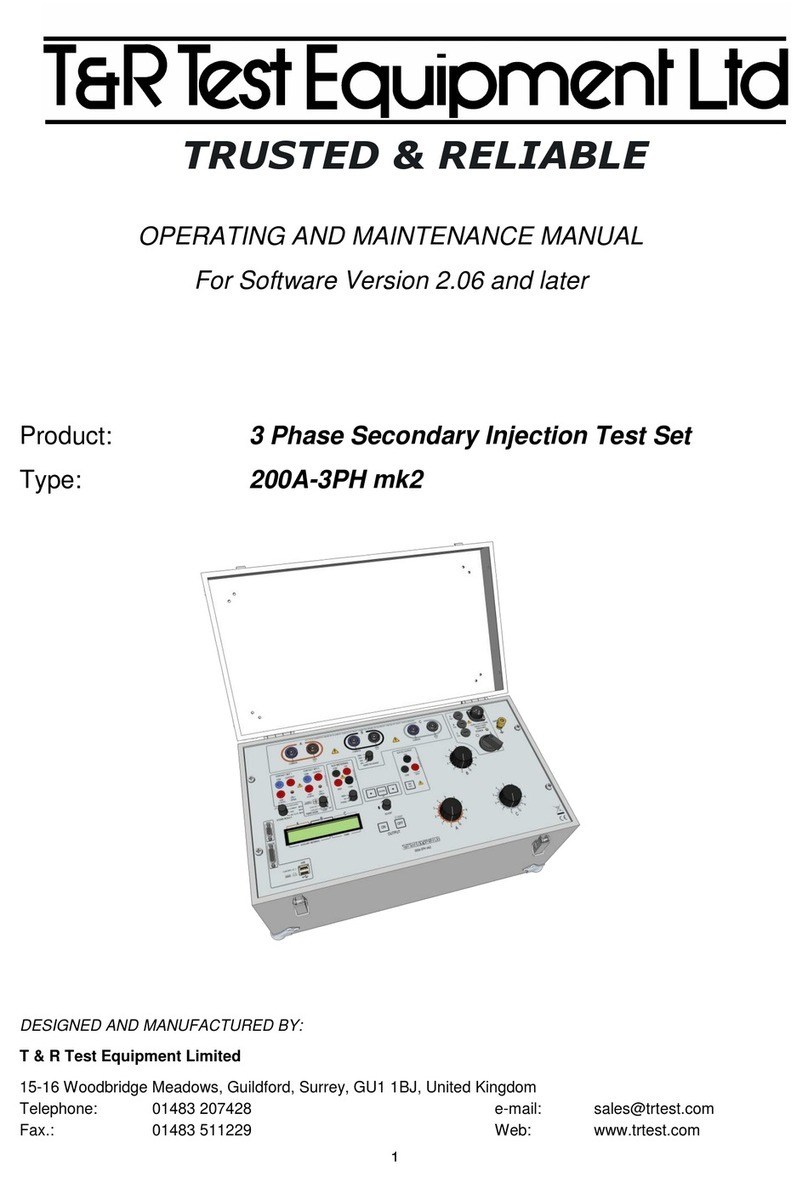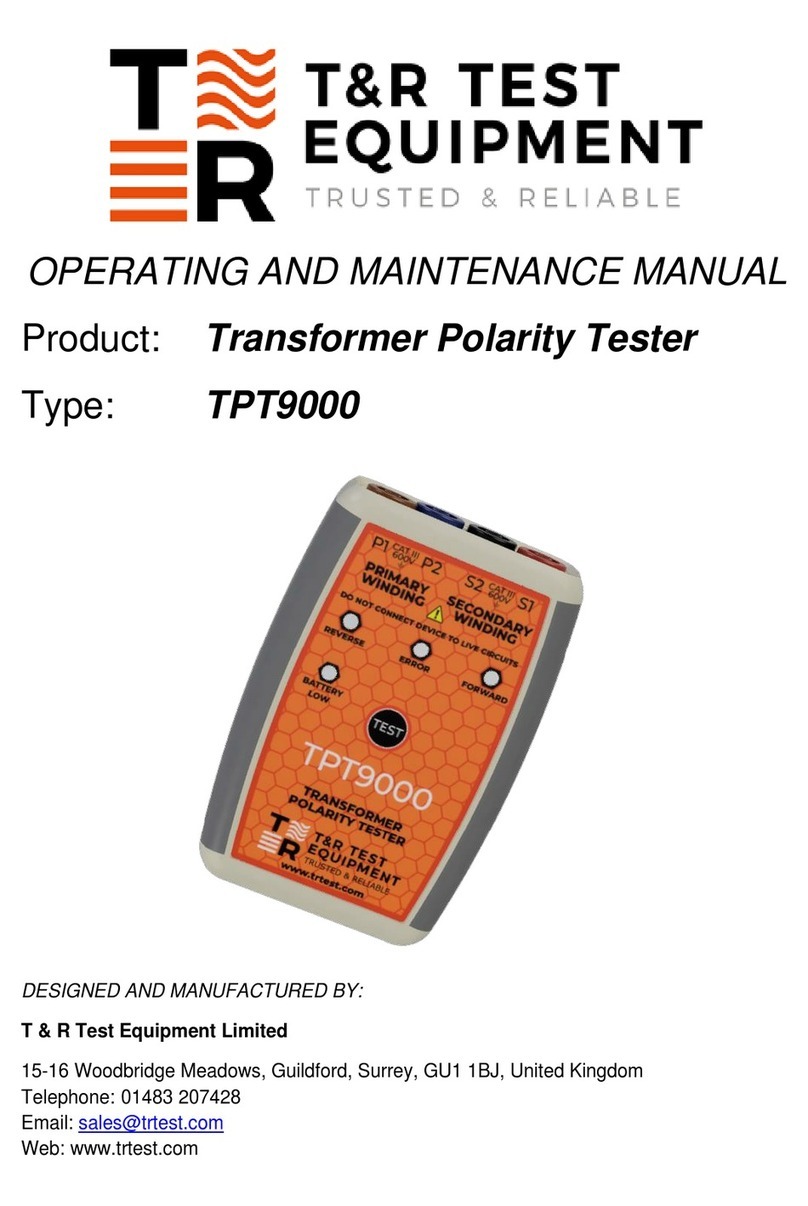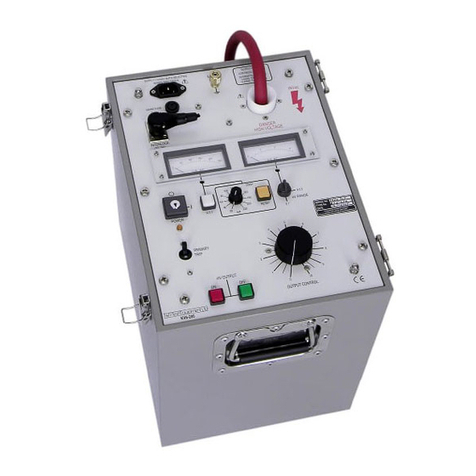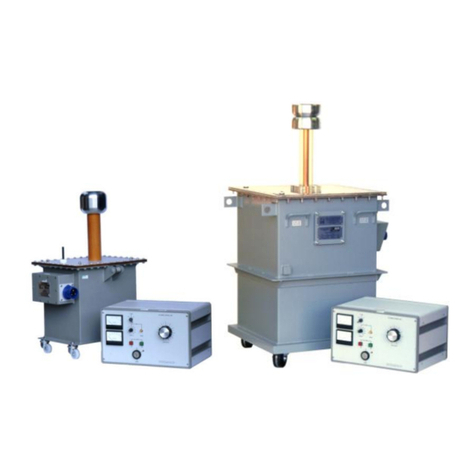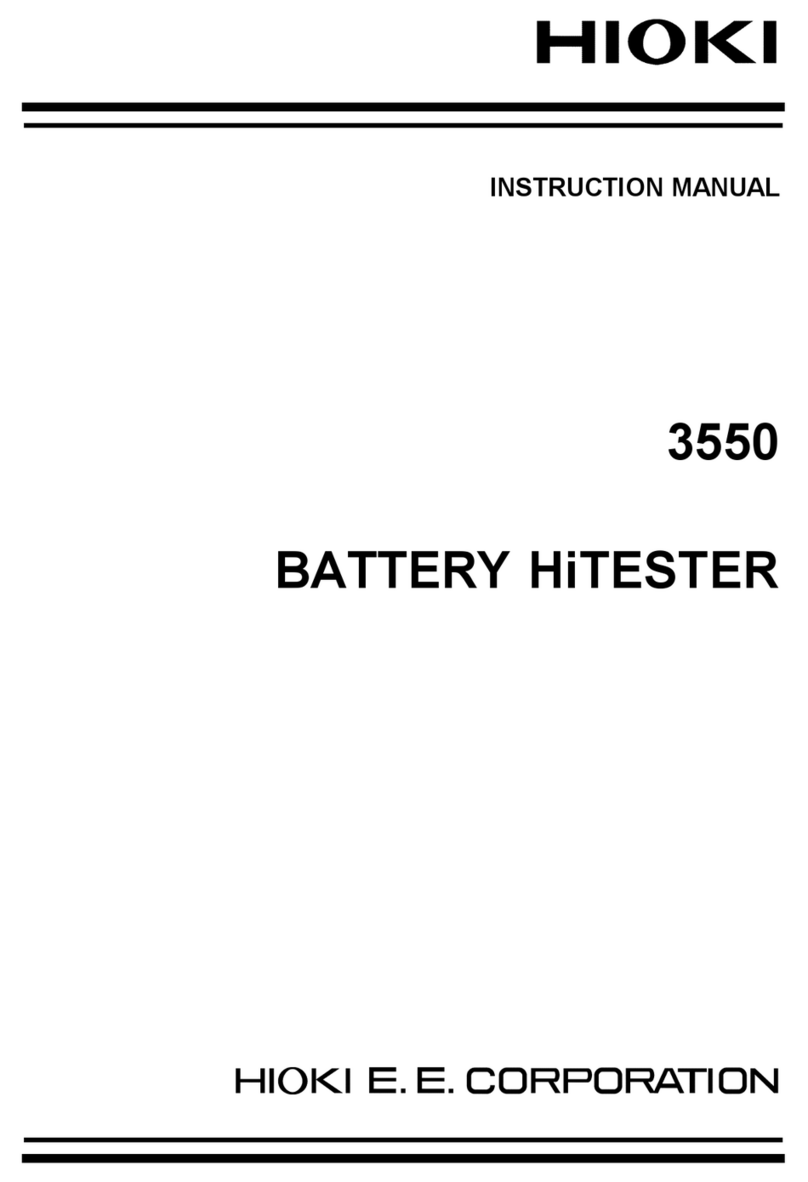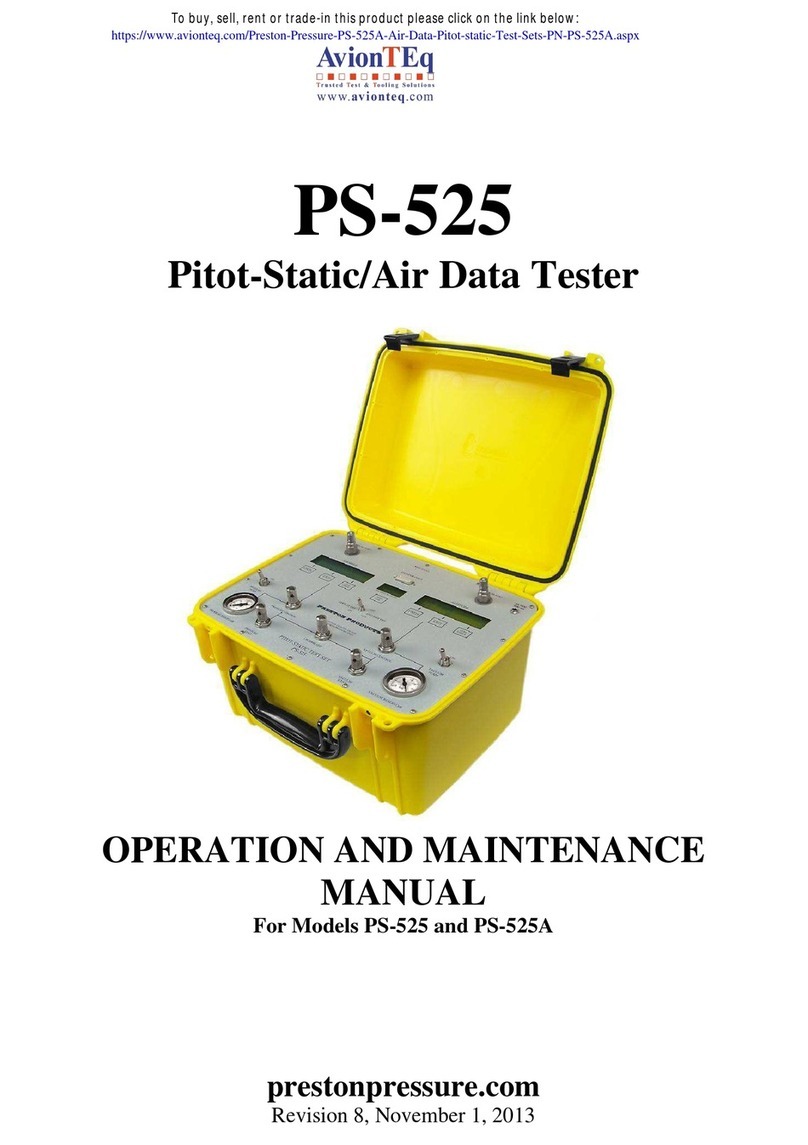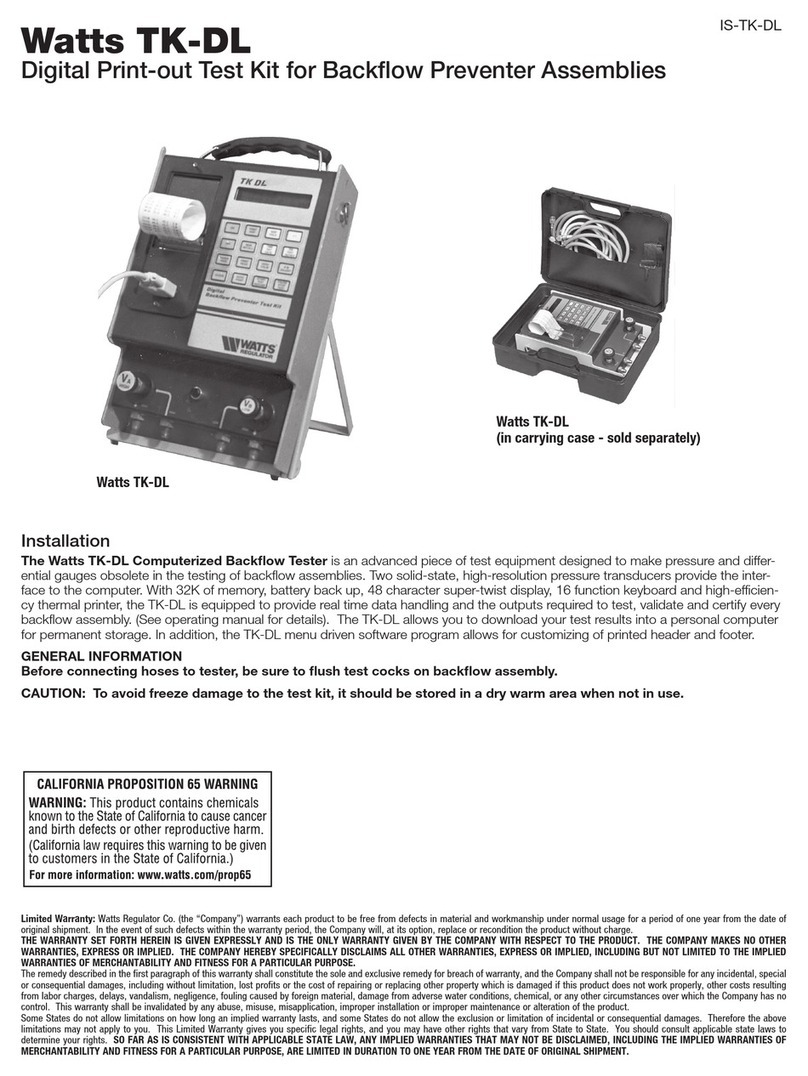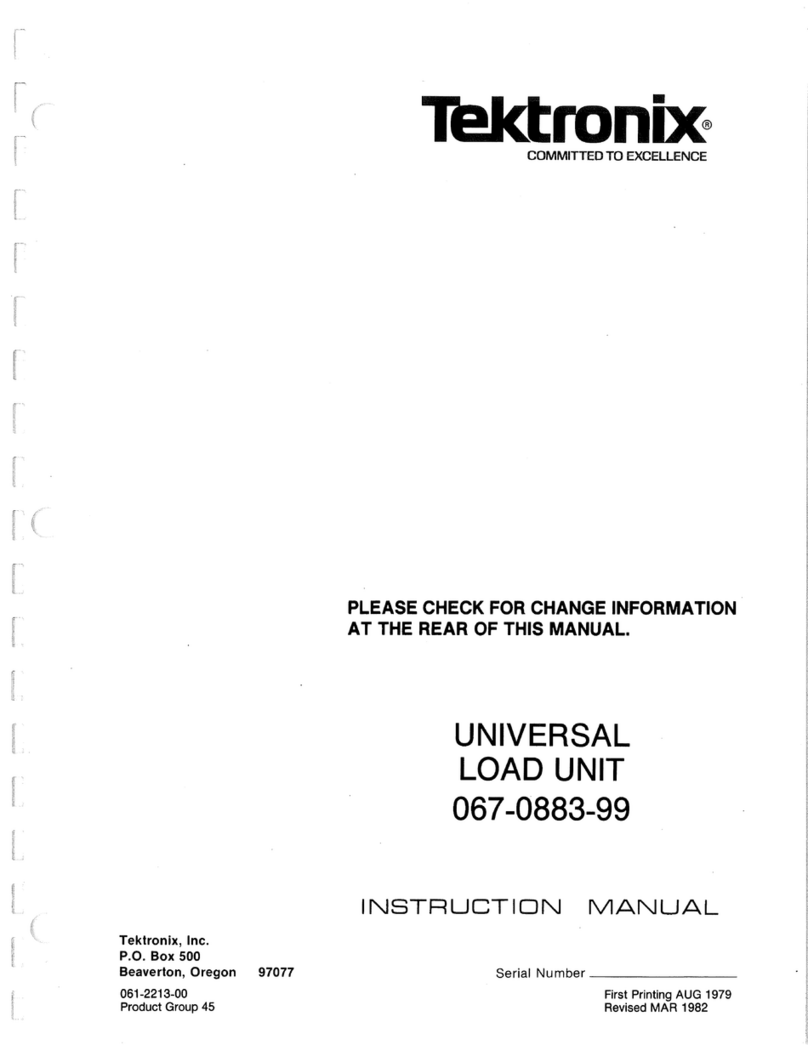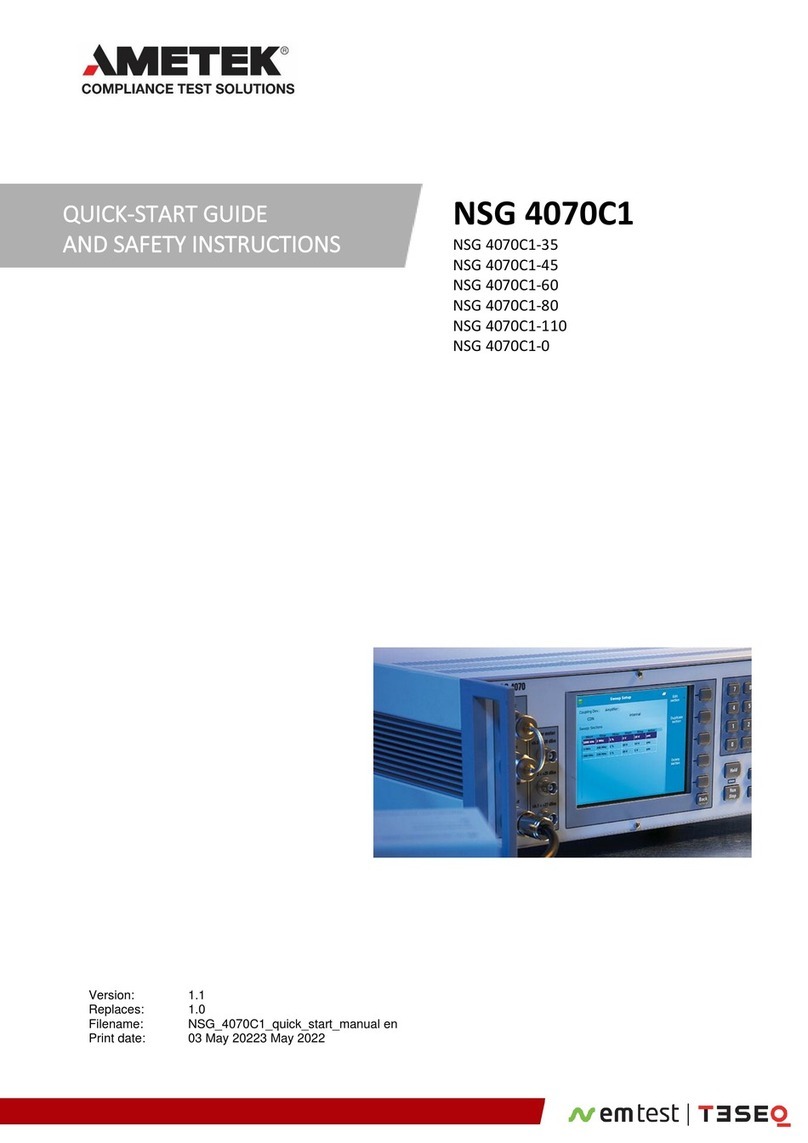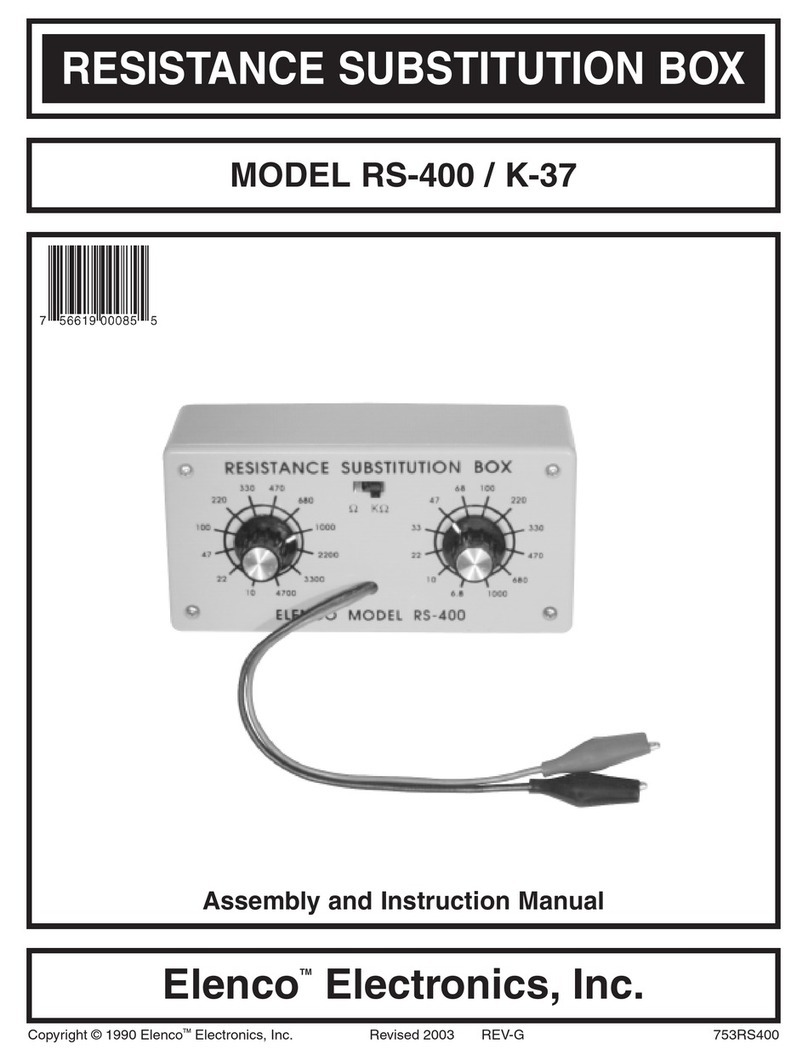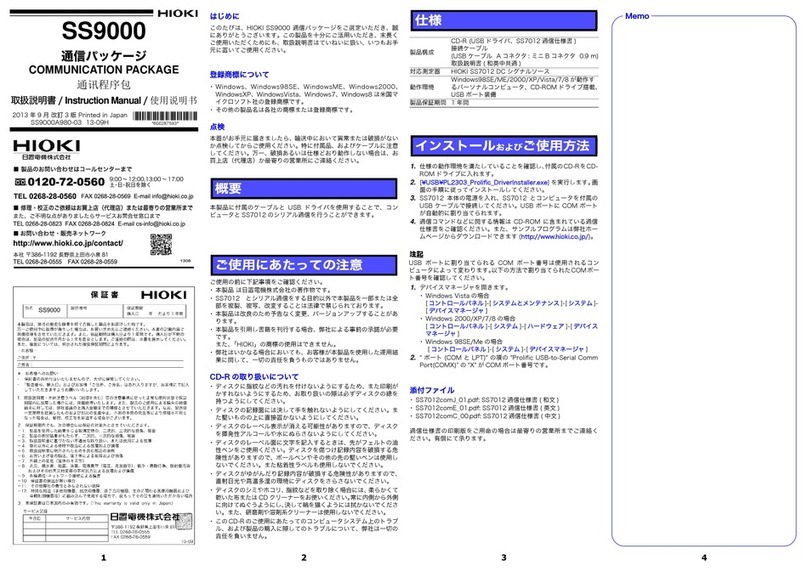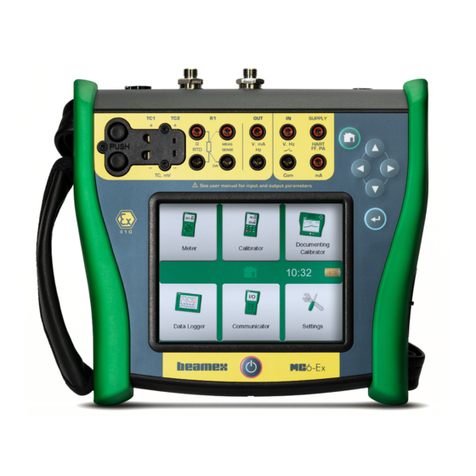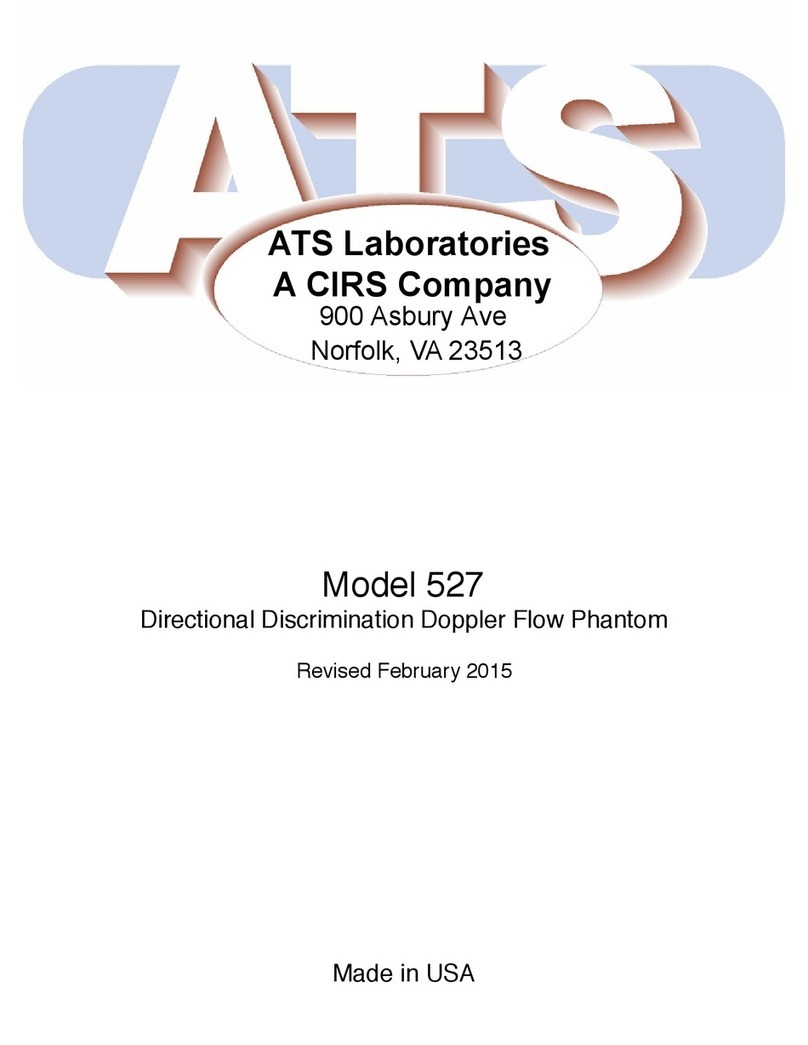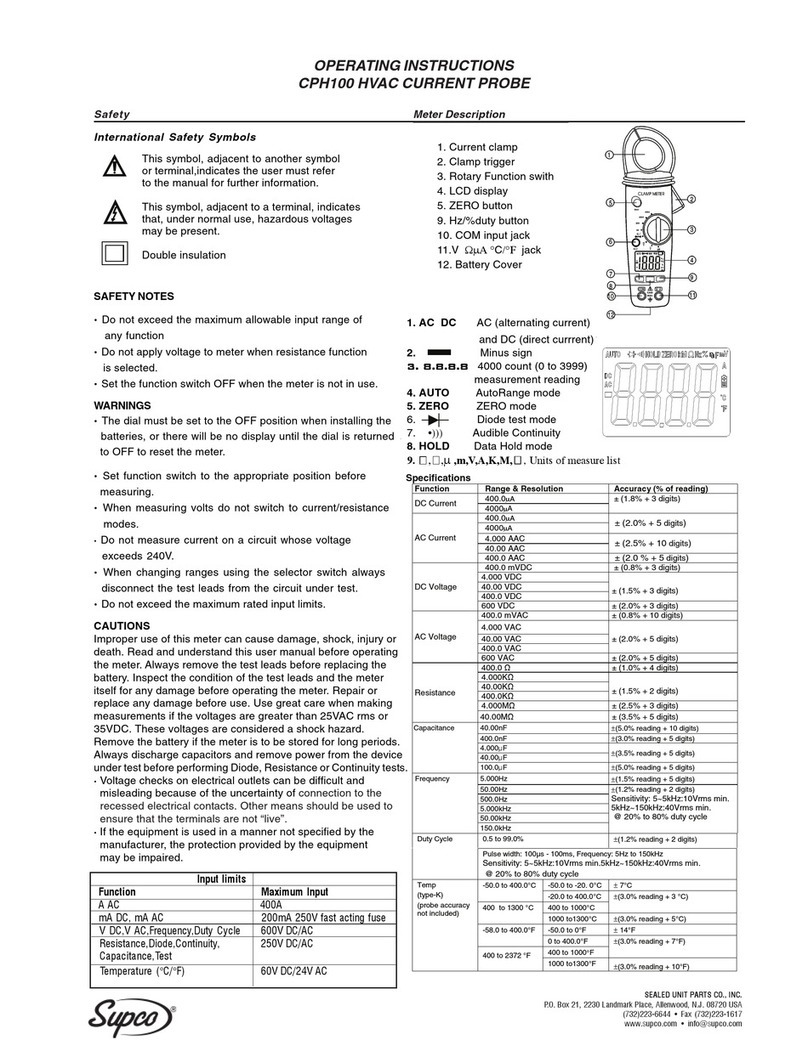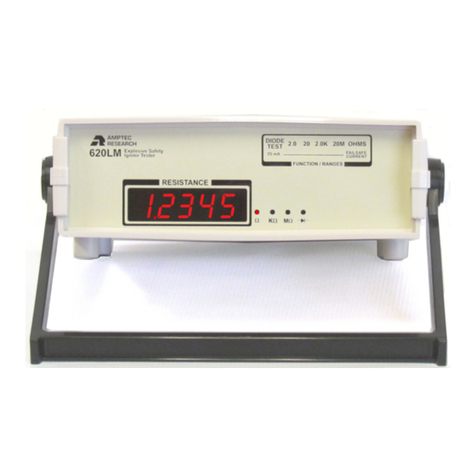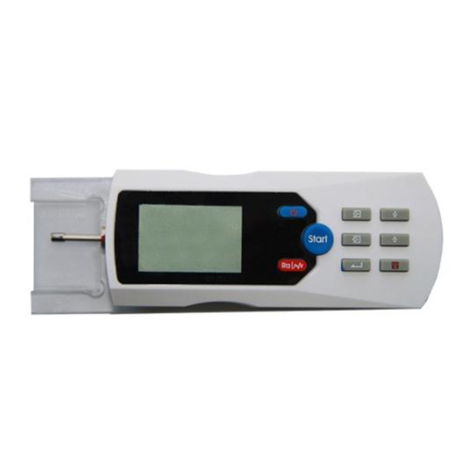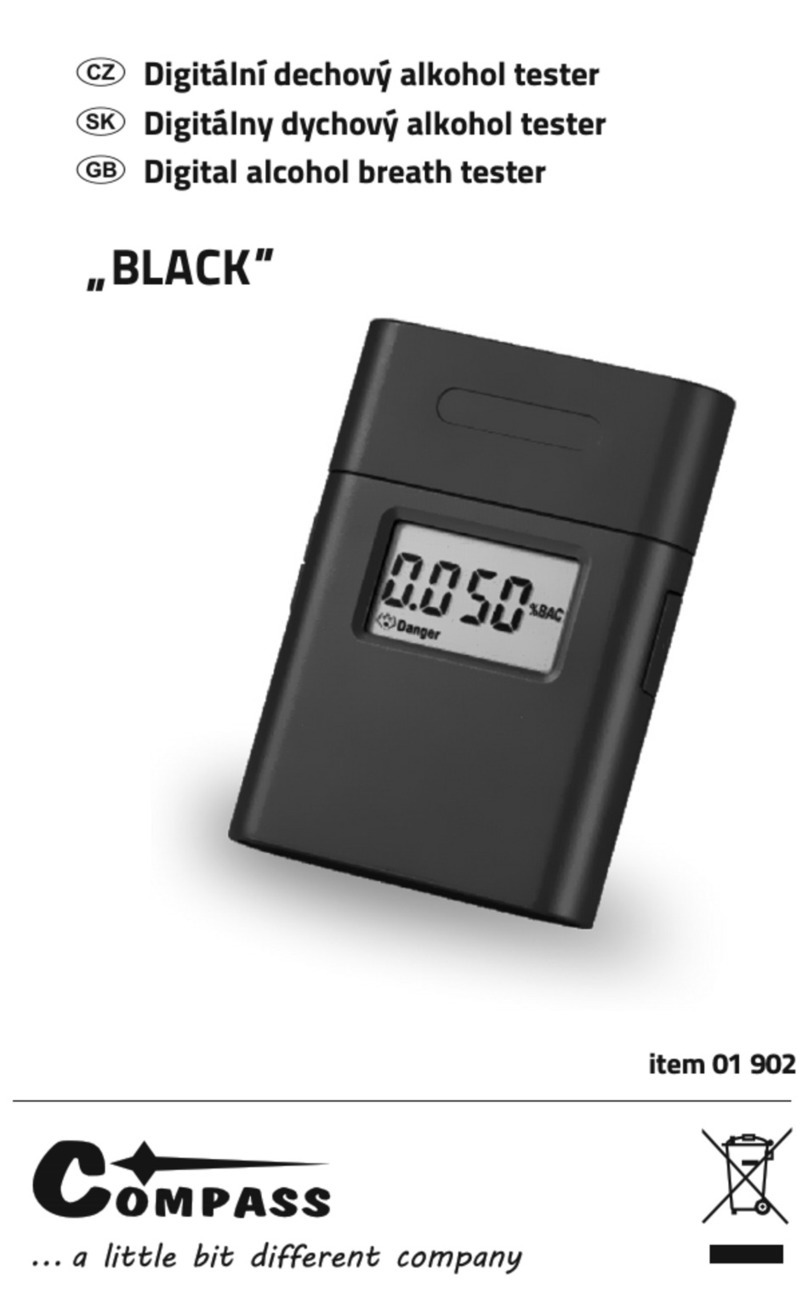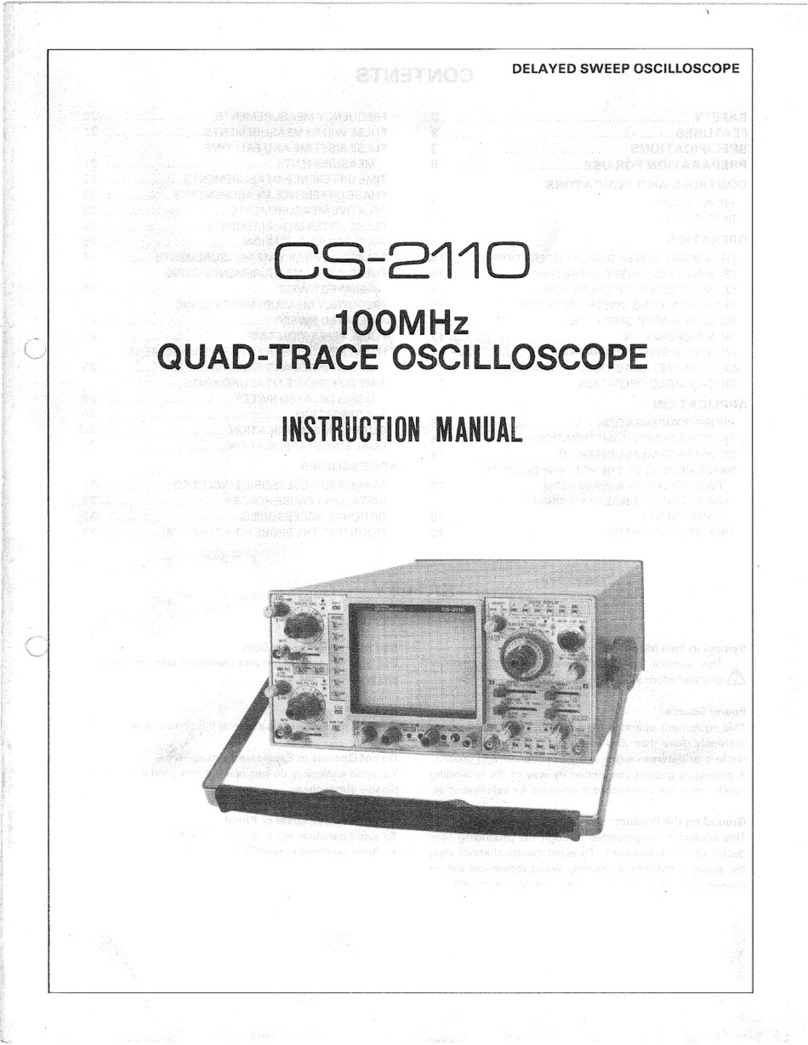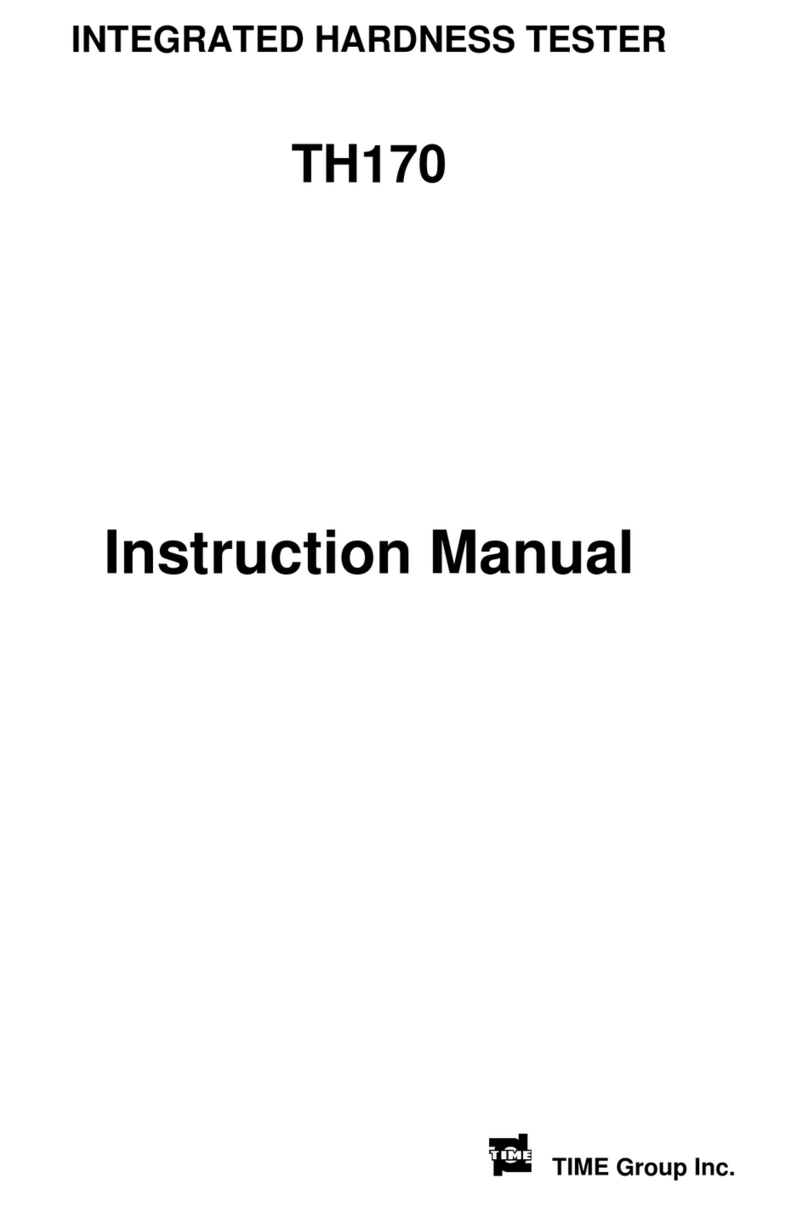T&R PCU2 mk5 Operating instructions

1
OPERATING AND MAINTENANCE MANUAL
Product:
Primary Current Injection System
Type:
PCU2 mk5
LU5000, LU6000, LU8000
DESIGNED AND MANUFACTURED BY:
T & R Test Equipment Limited
15-16 Woodbridge Meadows, Guildford, Surrey, GU1 1BJ, United Kingdom
Fax.: 01483 511229 Web: www.trtest.com


3
GENERAL SAFETY STATEMENT
WARNING
The following safety precautions should be reviewed to avoid injury to the user and damage to the
product (and other products connected to it). To avoid potential hazards only use this product as
specified.
Only suitably qualified personnel should use this equipment. Servicing of this product
should only be carried out by suitably qualified service personnel.
To Avoid Fire Hazards and Personal Injury
Use the correct power supply lead. Only use a suitably rated and approved power supply lead for
the country of use.
Ensure that systems that the unit is to be connected to are dead.
Do not connect and disconnect leads whilst outputs are switched on. Breaking the output circuit
with current flowing may cause potentially fatal arcing.
Ensure that the product is grounded. To avoid electric shock it is essential that the grounding
conductor is connected to the earth ground. An additional earth terminal is provided on the unit that
should be connected to a local earth. Ensure that the unit is properly grounded before making any
connections to inputs or outputs.
Terminal ratings must be observed to prevent fire hazards and risk of injury to the operator. Consult
the product manual for ratings information before making connections to any terminal.
It is ESSENTIAL to consult the product manual for rating information before making any connection
to a terminal or terminal group marked with a warning triangle.
Only use fuses of a type and rating specified for this product.
Do not operate the unit out of its case or with any covers or panels removed.
Do not touch exposed connections and components when power is present.
Do not operate the product if any damage is suspected. Refer the unit to qualified service
personnel to be checked.
Do not operate the unit in wet or damp conditions.
Do not operate the unit in an explosive atmosphere.
Do not leave the unit unattended during operation.
The PCU2 system has a very high output current (up to 6000A), and therefore generates large
magnetic fields around the output leads. Care must be taken in siting the unit next to items sensitive
to magnetic fields (such as computer monitors and other sensitive equipment).
Warnings from cardiac pacemaker manufacturers state that strong magnetic fields may affect
operation. Any high current unit such as the PCU2 should therefore not be operated by, or in the
vicinity of persons fitted with cardiac pacemakers or any other electronic or electrical medical
implants.
If any further queries occur regarding the usage and maintenance of the equipment detailed in this
manual, please refer these to the supplier of the equipment in the first case or to the manufacturer,
T & R Test Equipment Limited.

4
SAFETY TERMS AND SYMBOLS
The following safety symbols may appear on the equipment:
CAUTION/WARNING –Refer to manual
CAUTION –Hot. Parts may become hot during use –ensure parts are
cool before touching.
Mains off
Mains on
The following safety symbols may appear in this manual:
CAUTION
This action or procedure may be dangerous if not carried
out correctly, and may cause damage to the equipment or
connected equipment.
WARNING
This action or procedure may be cause injury or death to
the operator or other personnel if not carried out correctly
using applicable safety procedures.
CAUTION –
HOT
Parts of the equipment may become hot during use, and
must be allowed to cool before touching.

5
CONTENTS
1DESCRIPTION OF EQUIPMENT 7
1.1 Front Panel Layout 8
1.1.1 Loading unit 9
1.1.2 Control unit 9
1.2 Electrical Specification 10
1.2.1 Supply Specifications 10
1.2.2 Output Specifications 10
1.2.3 Output Lead Set Ratings 11
1.2.4 Metering 11
1.2.5 Overload trip 12
1.2.6 Loading unit over temperature trip 13
1.2.7 Timing System 13
1.3 Construction 13
1.4 Installation 13
2OPERATION 15
2.1 Loading Unit Configuration 15
2.2 Main Output 16
2.3 Connections 17
2.3.1 Earthing 17
2.4 Timing System 18
2.4.1 Timer Modes 18
2.4.2 General Procedure for Timing Tests 19
3APPLICATION NOTES –TESTING SPECIFIC DEVICES 21
3.1 Over-current Devices with Auxiliary Contacts 21
3.1.1 Timer Mode 21
3.1.2 Connections 21
3.1.3 Test Procedure 21
3.2 Timing of auto-reset/reclosing devices 22

6
3.2.1 Timer Mode 22
3.2.2 Connections 22
3.2.3 Test Procedure 22
3.3 Timing Devices with NO Auxiliary Contacts 23
3.3.1 Timer Mode 23
3.3.2 Connections 23
3.3.3 Test Procedure 23
4MAINTENANCE 24
5ACCESSORIES 25
5.1 Standard Accessories 25
5.2 Optional Accessories 25
6OVERALL PERFORMANCE SPECIFICATION 27
7REVISION 29

7
1 DESCRIPTION OF EQUIPMENT
The PCU2 is a primary current injection system designed to be used in conjunction with a T&R
Test Equipment loading transformer. Depending on the loading unit used, currents up to
6000A are available for 5 minutes and 12kA for 1 second.
Accurate true rms metering facilities and a flexible timing system are provided.
WARNING
The PCU2 and associated loading units are designed to be used on ‘dead’ systems (i.e.
no externally supplied voltages are present on the test object). Under no
circumstances connect the PCU2 or loading unit to a live system. Always check that
the power to the device under test is off and the circuit is isolated and grounded before
making any connections.
WARNING
The PCU2 and associated loading units are not designed for unattended operation.

8
1.1 Front Panel Layout
Figure 1.1 PCU2 and loading unit front panels

9
1.1.1 Loading unit
ITEM
FUNCTION
A
Output terminals
High current output to object under test
Caution –the output terminals and test
leads may become hot during use.
B
Power input
Power input from control unit
C
Metering output
Metering output to control unit
1.1.2 Control unit
ITEM
FUNCTION
D
Timer
Displays trip time of device under test
E
Contact inputs
Sense contact state of device under test
F
Timer mode switch
Select timer mode
G
Metering input
Metering input from loading unit
H
Ammeter
Displays load current
I
Ammeter range switch
Selects ammeter low/high range
J
Ammeter series/parallel switch
Selects Series/parallel connection for
metering
K
Loading unit output
Power output to loading unit
L
Pulse mode selector
Selects 0.5s pulse mode on output
M
Output on/off pushbuttons
Switches output on and off
N
Output control
Sets output current
P
Output circuit breaker
Protects output
Q
Mains on/off switch/circuit breaker
Isolates unit from mains supply
R
Auxiliary fuse
Metering and timing fuse
S
Power indicator
Power supply on indicator
T
Mains input
Mains supply inlet
V
Earth stud
Connect to local earth

10
1.2 Electrical Specification
1.2.1 Supply Specifications
Supply voltage: 230V 10%
Single phase, 50/60Hz
Maximum power requirement 23kVA 5 min on/15 min off
44kVA overload 1 second
1.2.2 Output Specifications
Loading
Unit
Output
arrangem
ent
Voltage
Current
Current
Continuous
5 min on/
15 min off
5 sec on/
1 min off
1 sec on/
1 min off
LU5000
Series
8V
1250A
2500A
4000A
5000A
Parallel
4V
2500A
5000A
8000A
10000A
LU6000
Series
6.6V
1375A
3000A
4800A
6000A
Parallel
3.3V
2750A
6000A
9600A
12000A
LU8000
Series
8V
1250A
2500A
4000A
5000A
Parallel
4V
2500A
5000A
8000A
10000A
The maximum output current in the series or parallel arrangement is available with a duty
cycle of 5 minutes on followed by 15 minutes off.
Details of configuring the output to series or parallel mode may be found in section 2.

11
1.2.3 Output Lead Set Ratings
The optional 3000AL, 4000AL, 5000AL, 6000AL lead sets supplied for use with the PCU2 are
made up from a number of 70mm2cores and have different continuous and intermittent
ratings. The rating is also affected by the arrangement of the individual 70mm2cables making
up the high current cable. The leads are supplied with the cables strapped together, but to
achieve their maximum rating the straps must be cut and the cores laid out side by side whilst
testing.
Lead set type
Continuous rating
5 minute on/ 15
minute off rating
1 sec on/ 1
minute off
rating
Cores strapped
together
Cores laid out
flat
Cores strapped
together
Cores strapped
together
3000AL
1200A
3000A
1500A
6000A
4000AL
1400A
4000A
2000A
8000A
5000AL
1600A
5000A
2500A
10000A
6000AL
1800A
6000A
3000A
12000A
8000AL
1800A
6000A
3000A
12000A
CAUTION
The cables and terminals will become hot in use. Ensure adequate cooling time is allowed
before touching cables or connectors after tests.
Note: The output leads should not be rested against any sharp edges whilst testing. The insulation
on the cables softens as it heats up, and it is possible for sharp edges to damage the
insulation on the cable under these circumstances. Eddy current heating may occur in ferrous
metals that the pair of cable rests against, and this could heat the cable insulation further.
1.2.4 Metering
The output current is metered by a digital memory ammeter with an LED display. The current
reading is continuously updated when the output is energised, and the value held when the
output is de-energised.
In timing modes where the contact inputs are used to signify the end of a test, the last valid
current measurement before the contacts changed state is held. This also occurs when using
the current operated timer mode.
The ammeter’s minimum response time is 200ms to capture a reading. If the duration of the
current is less than 200ms the ammeter’s display will display “Err”.

12
The full scale range of the ammeter is dependant on the loading unit. A switch is provided on
the PCU2 to switch the meter between the series and parallel range.
Loading Unit
Output
arrangement
Ammeter
range
Meter full
scale
Resolution
Accuracy
LU5000
LU8000
Series
Low
2500A
1A
0.6% 6d
High
5.00kA
10A
0.6% 6d
Parallel
Low
5000A
1A
0.6% 6d
High
10.00kA
10A
0.6% 6d
LU6000
Series
Low
3000A
1A
0.6% 6d
High
6.00kA
10A
0.6% 6d
Parallel
Low
6000A
1A
0.6% 6d
High
12.00kA
10A
0.6% 6d
If the metering cable is not connected between the PCU2 MK5 control unit and the external
loading unit, the ammeter will not function and the output will not switch on.
1.2.5 Overload trip
The output of the unit is protected by an overload trip that operates at approximately 115% of
full load current.
Loading Unit
Output
arrangement
Metering range
Overload trip
current
LU5000
LU8000
Series
Low
2875A
High
5750A
Parallel
Low
5750A
High
11500A
LU6000
Series
Low
3450A
High
6900A
Parallel
Low
6900A
High
13800A
The unit is also protected by a circuit breaker on the control unit output. This will trip before the
electronic trip on high range (at approximately 10000A for an LU5000/8000 or 12000A for an
LU6000).

13
1.2.6 Loading unit over temperature trip
An over-temperature trip is fitted on the transformer in the loading unit. If an over-temperature
condition occurs, the control unit output will be switched off and the output will be disabled
until the unit has cooled. While the output is disabled, both the red ON pushbutton and the
green OFF pushbutton will be extinguished. When the unit has cooled sufficiently to continue,
the green OFF pushbutton will light.
1.2.7 Timing System
Contact open circuit voltage 24Vdc
Contact short circuit current 100mA
The PCU2 is fitted with an integrated timing system which is linked to the main output and two
sets of contact inputs. The system is highly flexible, and allows for the timing of all common
protection devices and trips. The timer may also be used to time external events not linked to
the output of the set.
Full details of operating the timer are given in section 2.
Timer mode
Range
Resolution
Accuracy
Internal start
0-999.999s
1ms
0.01% rdg 2d
Single contact
0-999.999s
1ms
0.01% rdg 2d
Dual contact
0-999.999s
1ms
0.01% rdg 2d
Current operated
0-999.999s
1ms
0.01% rdg 3d
NOTE: In current operated mode timing results obtained with test currents below 20% of the selected
ammeter range, and on measured times of 19ms and below, are of doubtful accuracy.
The PCU2 has two contact inputs which are used to start and stop the timer depending on the
mode selected. Contact set 1 has a connection for volt-free contacts and for triggering by a
DC voltage, and contact set 2 has a connection for volt-free inputs. In each case, the input
auto-selects for normally open or normally closed contacts. The contact state is shown by an
LED that is off when the contact is closed and on when the contact is open.
The maximum open circuit voltage across the contact input is 24V, and the short circuit current
through the contacts is limited to 100mA.
1.3 Construction
The PCU2 MK5 control unit is housed in a robust steel case with castors for mobility. The
front panel is protected by a steel cover which is fixed to the main case with catches. The unit
is also fitted with steel handles at each end of the main chassis.
The external loading unit is housed in a steel case which is similar in construction to the PCU2
control unit. The loading unit is not fitted with a protective cover.
1.4 Installation
The PCU2 and associated loading units are designed for use in an indoor environment.

14
Before installation, a suitable mains connector must be connected to the 3-core mains input
cable provided. The connector and supply must be rated for 100A. It is also important to
ensure that the unit is adequately earthed. It is suggested that the earth stud on the side of the
unit is connected to a low impedance local earth. This is essential if the unit is used in a sub-
station environment.

15
2 OPERATION
This chapter describes how to use the PCU2 and loading unit in a variety of applications.
Specific examples are given in the applications section. The interconnections between the
control unit and loading unit are shown in figure 2.2.
2.1 Loading Unit Configuration
The loading units have two output windings which may either be connected in parallel or
series, allowing the output to be configured for a higher current with a lower voltage or a lower
current with a higher voltage.
The links on the control unit must be connected to select series or parallel operation:
Configuration
Link
terminals
Series
2-3
6-7
Parallel
1-3
2-4
5-7
6-8
Figure 2.1 Loading unit series/parallel selection
To change the links, first remove all eight retaining nuts, and then remove the output terminal
plates. Re—configure the links as required, and then replace the output terminal plates and
nuts. Ensure that all of the nuts are tightened.
The switch on the control unit must also be set to “series” or “parallel” to set the ammeter to
the correct range.

16
The current and voltage available from each loading unit in series or parallel mode is shown
below.
Loading
Unit
Output
arrangement
Voltage
Current
Current
Continuous
5 min on/
15 min off
5 sec on/
1 min off
1 sec on/
1 min off
LU5000
Series
8V
1250A
2500A
4000A
5000A
Parallel
4V
2500A
5000A
8000A
10000A
LU6000
Series
6.6V
1375A
3000A
4800A
6000A
Parallel
3.3V
2750A
6000A
9600A
12000A
LU8000
Series
8V
1250A
2500A
4000A
5000A
Parallel
4V
2500A
5000A
8000A
10000A
2.2 Main Output
The main output from the PCU2 control unit is a 0-230V supply rated at 100A for 5 minutes
on/15 minutes off. This output is NOT isolated from the mains, and is not designed to be used
without an isolating loading unit. The units are designed to drive the T&R LU5000-LU8000
loading units, which provide an isolated low voltage high current output.
The main output is switched on and off using the on and off pushbuttons. The current level is
controlled by the main output control and protected by the output circuit breaker.
The main output may be switched to continuous mode or pulse mode. In pulse mode the
output switches on for 0.5s when the output on button is pressed. This is particularly useful for
setting up the current into thermal devices to reduce heating in the load.

17
2.3 Connections
The connections between the PCU2 and loading unit are shown in figure 2.2.
6
7
LOADING UNIT
CONTROL UNIT
MAINS
SUPPLY
LOADING UNIT POWER CONNECTION
METERING CONNECTION
OUTPUT
3
2
15
OUTPUT TERMINAL
48
OUTPUT TERMINAL
LU5000
CONTROL UNIT
3
26
7
3
26
7
Figure 2.2 PCU2 and loading unit connections
WARNING
It is vital to ensure that secure, low impedance connections are made between the output of
the loading unit and the object under test. Ensure that the output cables are suitable rated for
the test current to avoid danger of fire. If the connection to the load is broken whilst current is
flowing, arcing may occur.
CAUTION
The output terminals and test leads may become hot during use. Allow adequate time to
cool after the test before touching.
2.3.1 Earthing
If the supply earth to the PCU2 is of doubtful integrity the earth terminal on the PCU2 should
be connected to a solid local earth.

18
2.4 Timing System
The PCU2 timing system is very flexible, and is closely integrated with the main output. A
summary of the start and stop events for the timer is shown in the table below.
Timer Mode
Timer Start Condition
Timer Stop Condition
Off
-
-
Internal Start
Main output on
Contact set 1 change
Single Contact
Contact set 1 change
Contact set 1 change
Dual Contact
Contact set 1 change
Contact set 2 change
Current Operated
Current >20% of range
Current <20% of range
The timer is reset by pressing the small pushbutton on the front of the timer display. In each
mode that the timer is active, the output of the unit must be switched on to arm the timer.
Contact set 1 has a contact input for volt-free contacts and a Vdc input for dc voltages. The
Vdc input may be used to trigger the timer from a dc voltage, and will trigger from either the
voltage switching from zero to 24-240Vdc or 24-240Vdc to zero. The voltage must be
connected with positive to the red “Vdc” terminal and negative to the blue “com” terminal.
Contact set 2 has a volt-free contact input.
2.4.1 Timer Modes
2.4.1.1 Timer Mode: Off
In the ‘off’ mode, the timer has no effect on the operation of the set, and the timer does not
run. This mode is used to set the required current through the test object before a timing test.
2.4.1.2 Timer Mode: Internal Start
The internal start mode starts the timer when the main output is switched on, and stops the
timer on the first change of contact set 1. When the timer is stopped, the output of the unit is
automatically switched off.
2.4.1.3 Timer Mode: Single Contact
In single contact mode, the timer starts on the first change of state of contact set 1 after the
output is switched on, and stops on the second change on contact set 1. The output is
automatically switched off when the timer is started. The timer is reset when the output is
switched on. This timer mode is ideally suited to timing auto-reclose devices.
2.4.1.4 Timer Mode: Dual Contact
Dual contact mode uses both contact set 1 and contact set 2. The timer starts on the first
change of contact set 1 after the output is switched on, and stops on the first change of
contact set 2. The output of the unit is automatically switched off when the timer starts.

19
2.4.1.5 Timer Mode: Current Operated
Current operated mode is used to time devices that have contacts in series with the current
sense element. This includes many types of circuit breakers and trips.
The timer is started when the output current exceeds 20% of full scale of the selected
metering range, and stops when the current falls below this threshold.
2.4.2 General Procedure for Timing Tests
2.4.2.1 Connections
Ensure that the unit is switched off and the test object is isolated and grounded before making
any connections.
Connect the loading unit to the control unit as shown in figure 2.2.
Select the desired series/parallel output arrangement on the loading unit, and connect the
output cables to the test object. Select the appropriate loading unit series/parallel position on
the PCU2 loading unit connection switch.
Connect the supply lead to the mains and move the supply switch to the on position. The
supply on lamp should now be illuminated.
2.4.2.2 Testing
It is advisable to make a preliminary test on the test object, starting at zero voltage, in order to
test the load impedance, before performing the test with regulator set at higher values.
Therefore, ensure the regulator knob is fully anti-clockwise before switching on.
Ensure the timer mode switch is in the off position, and depress the on push-button. Increase
the current by rotating the output control knob in a clockwise direction until the desired current
is indicated on the ammeter. Press the output off push-button.
Connect the test object contacts to the contact terminals on the test set, select the internal
start timer mode, and reset the timer if necessary. If the test object has no auxiliary contacts
(e.g. thermal breakers), it will be necessary to use the current operated timer mode.
When the output on pushbutton is pressed, the following will occur:
a. The timer will start and current will flow through the test object.
b. When the test object's contacts change state the timer will stop and the test current
will be automatically switched off.
c. 2 seconds must now elapse before the timer function is active and ready for a repeat
test.
It is usual to repeat a test several times, checking that the times are consistent. However, it is
advisable to allow the device under test to cool between tests particularly if the test is being
carried out at large over-current factors.
2.4.2.3 After Testing
On completion of the test, return the regulator to zero and switch off the supply. Before
disconnecting the test object ensure the mains supply switch is in the OFF position.

This manual suits for next models
3
Table of contents
Other T&R Test Equipment manuals

T&R
T&R 200A-3PH Operating instructions
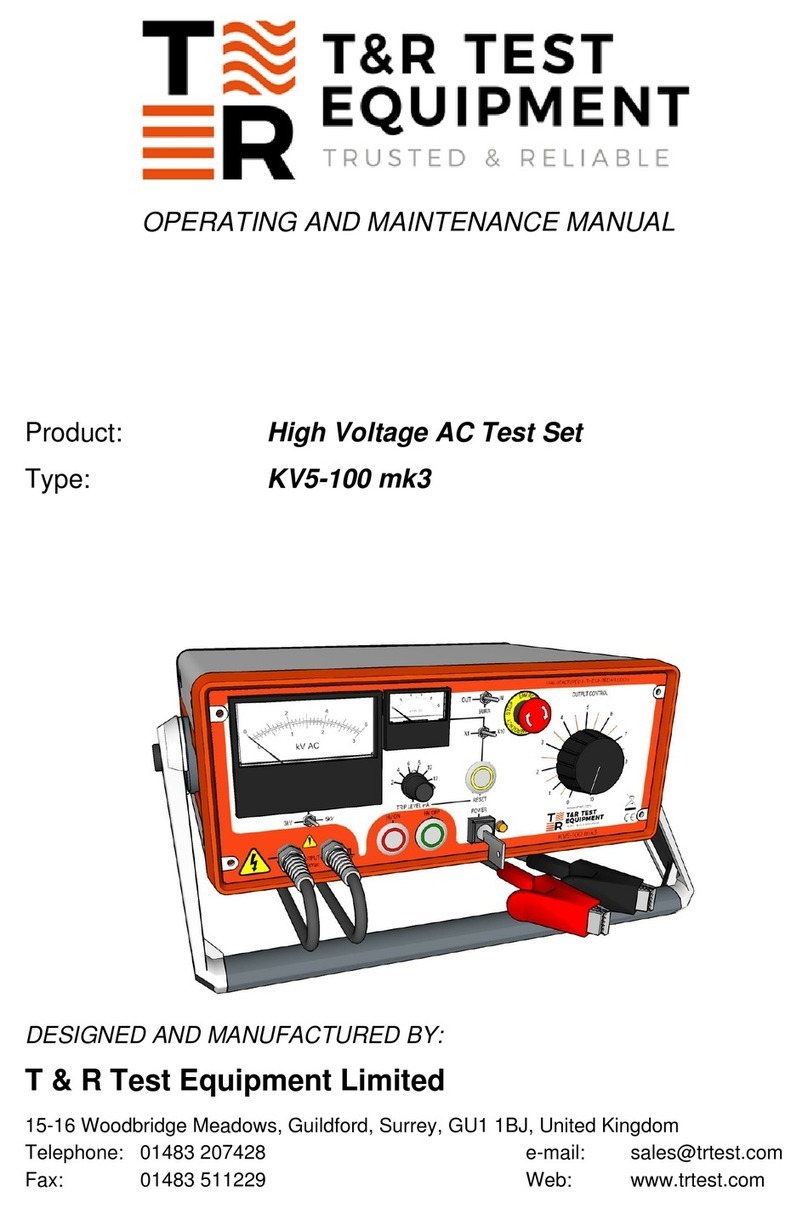
T&R
T&R KV5-100 mk3 Operating instructions
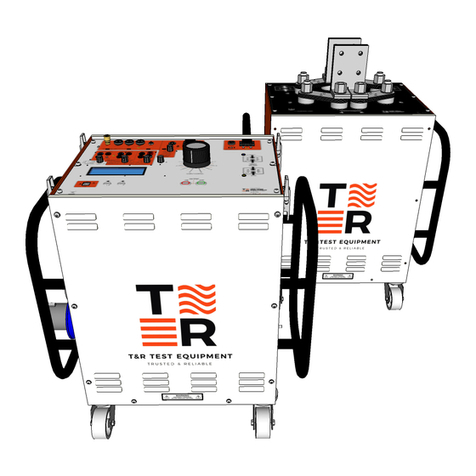
T&R
T&R CU-Ps Operating instructions
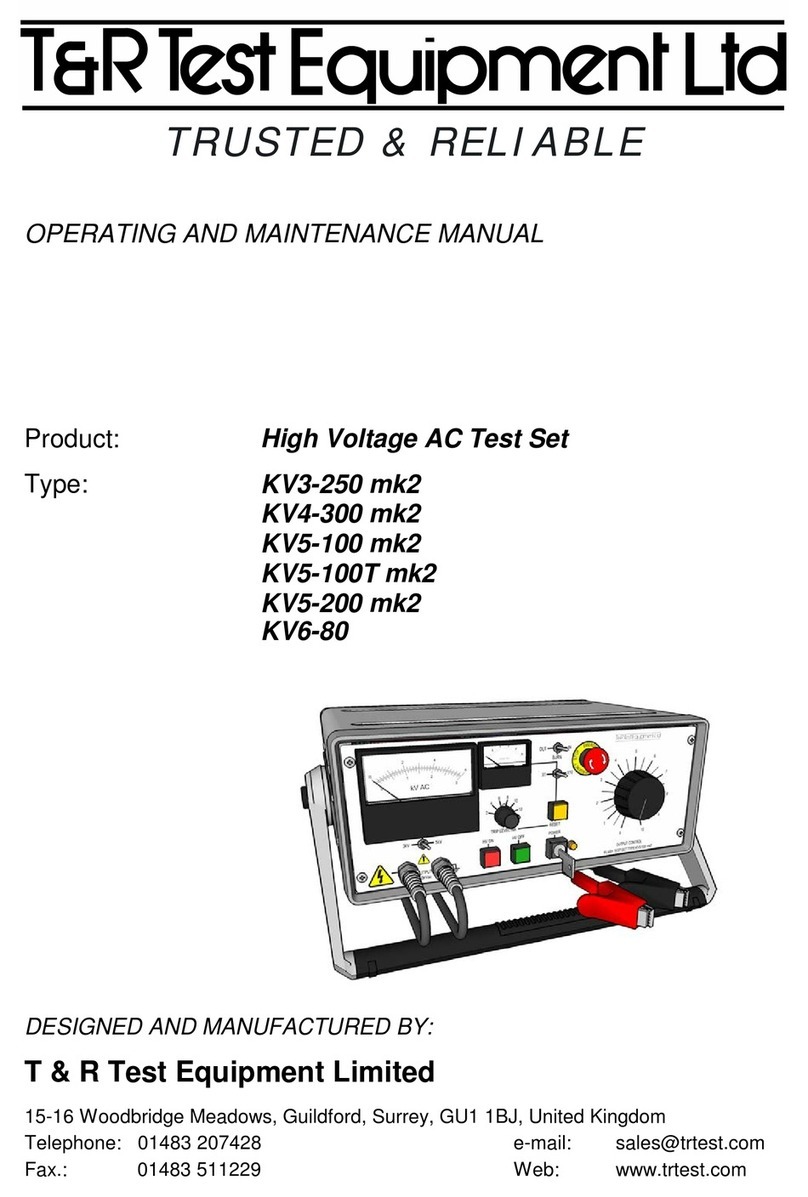
T&R
T&R KV6-80 Operating instructions
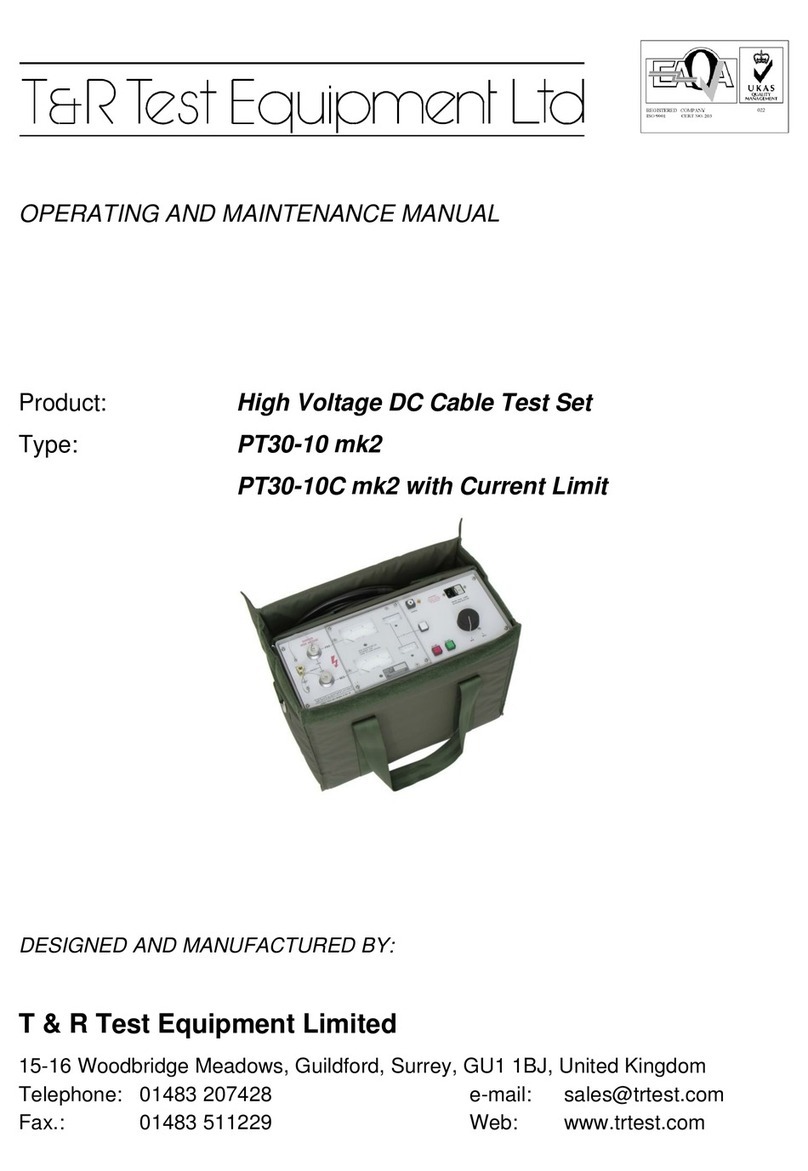
T&R
T&R PT30-10 mk2 Operating instructions
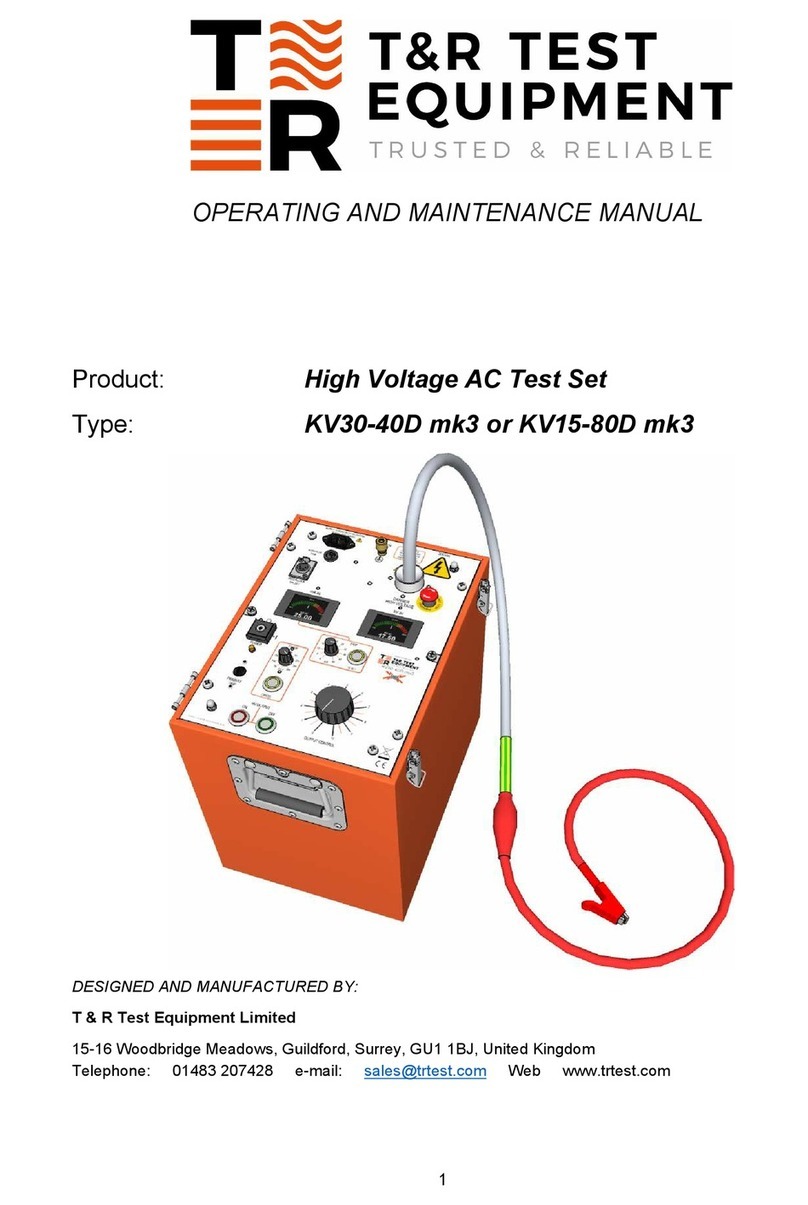
T&R
T&R KV30-40D mk3 Operating instructions
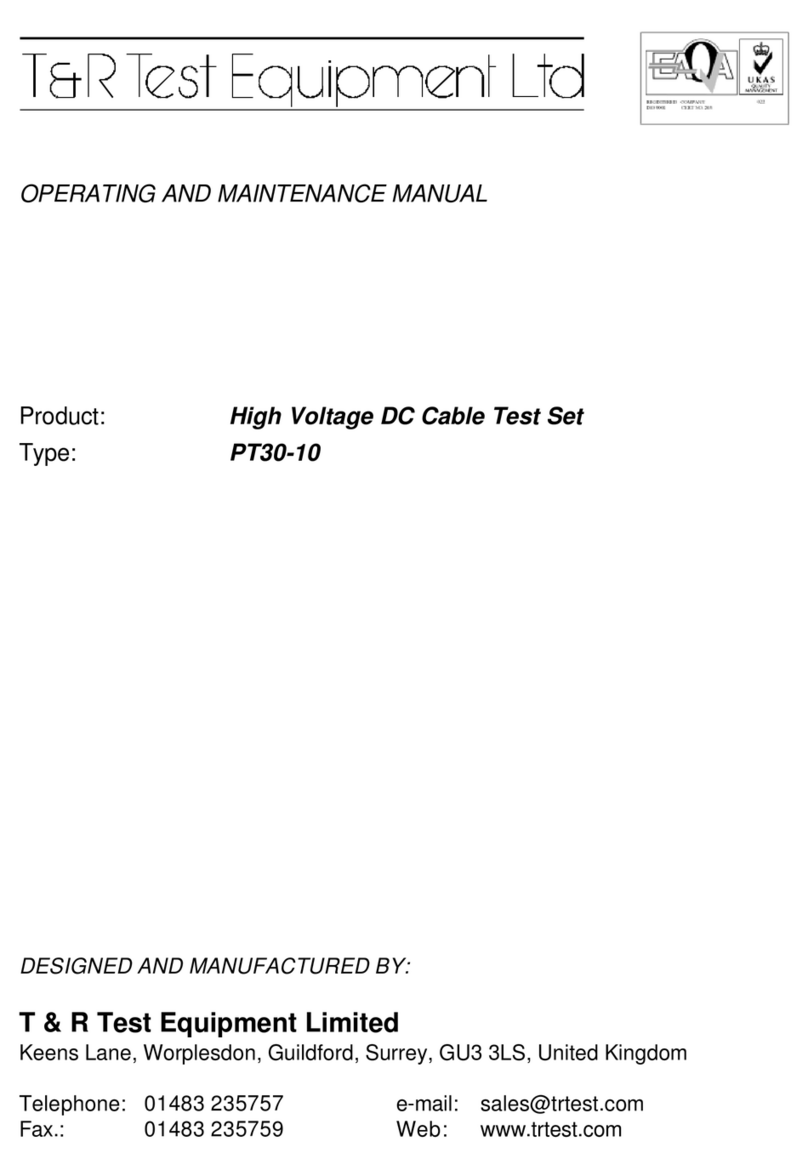
T&R
T&R PT30-10 Operating instructions
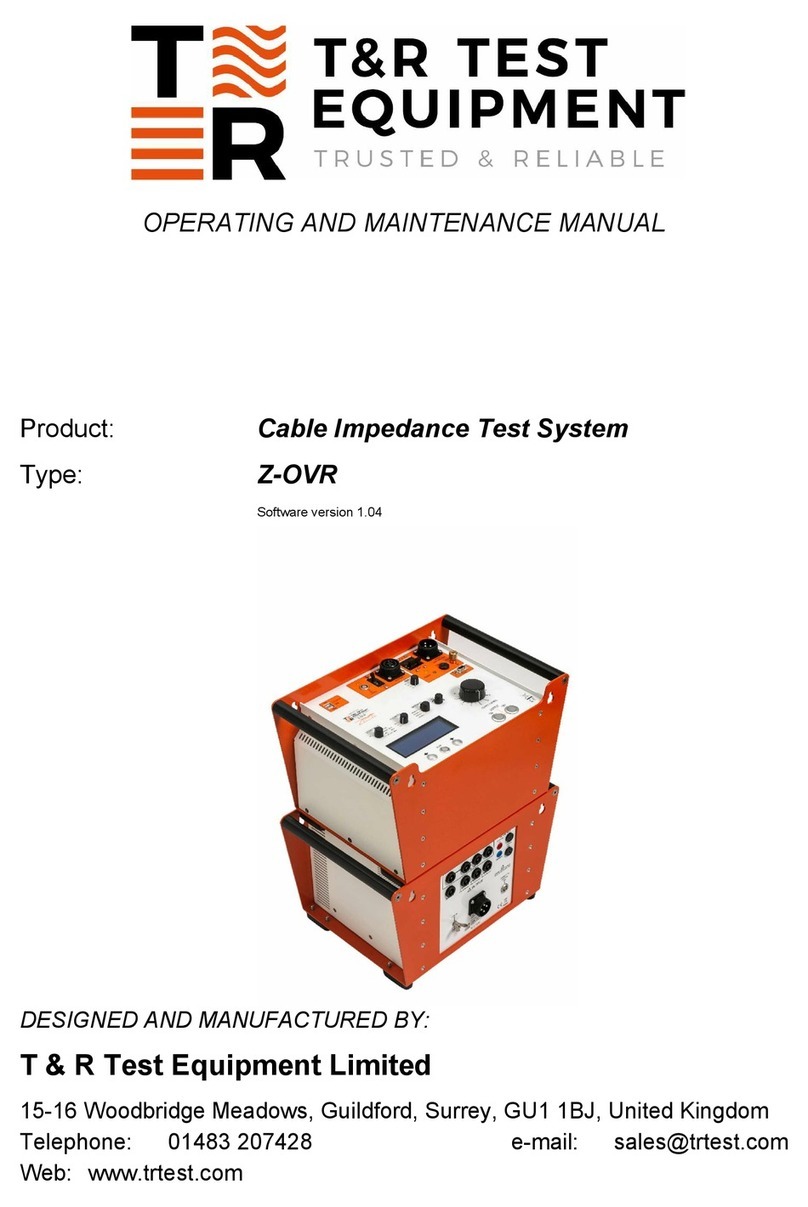
T&R
T&R Z-OVR Operating instructions
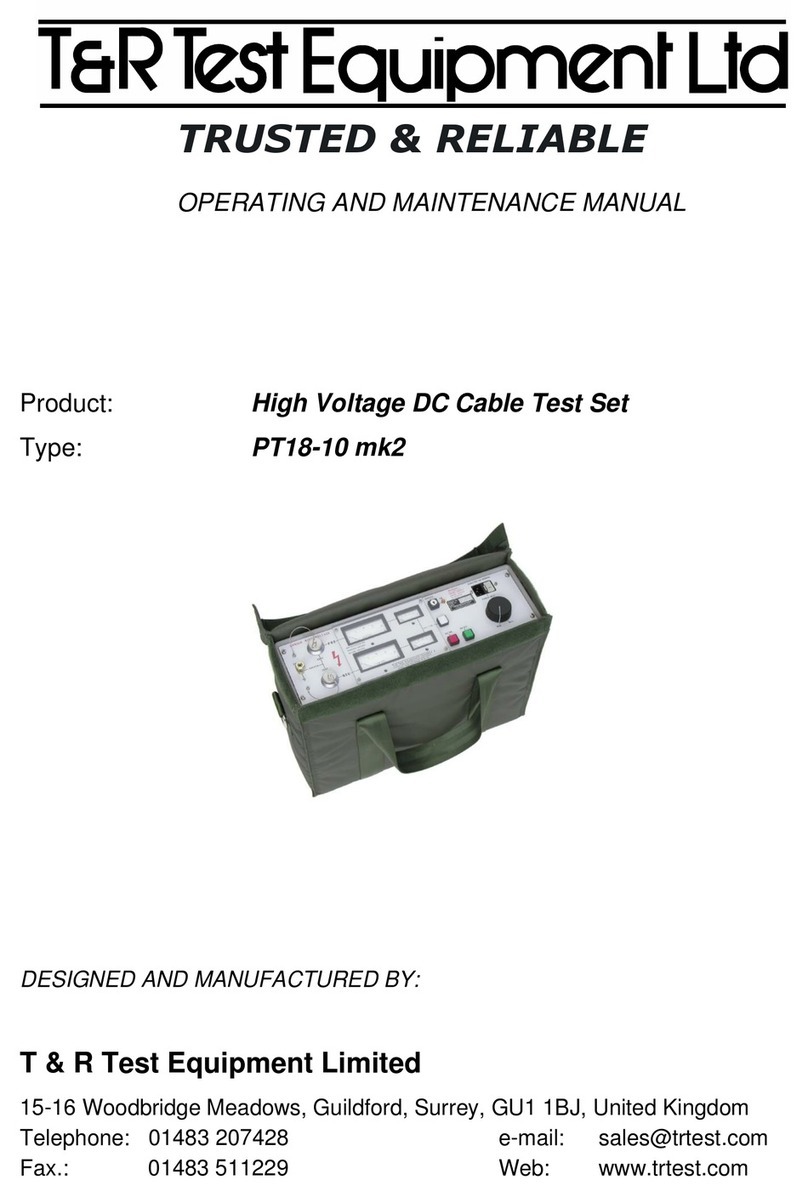
T&R
T&R PT18-10 mk2 Operating instructions
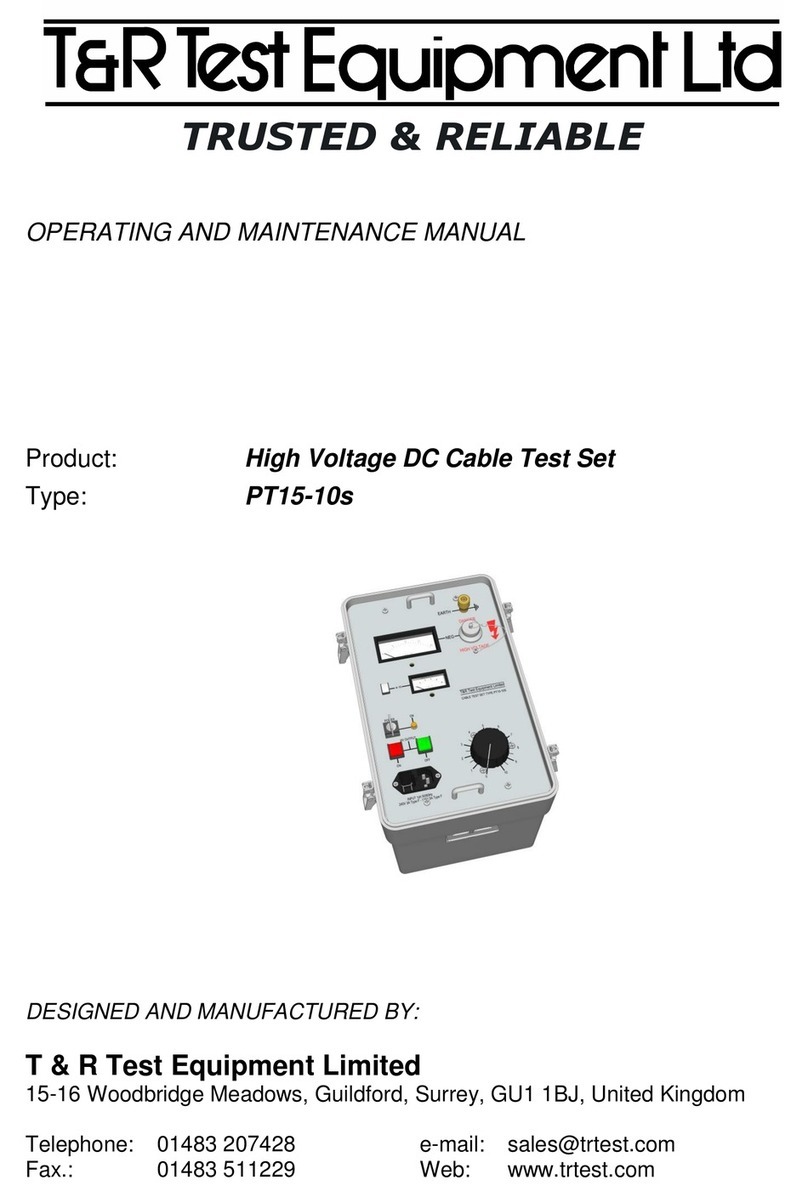
T&R
T&R PT15-10s Operating instructions
